New ECS DeskNote in 2003
Looking back at the year passed since the so-called desknotes (notebooks on the desktop components) have appeared, I can state the certain commercial success of this product line. Having emerged as an alternative to notebooks based on far more expensive processors and other components, desknotes became the good buy for many users due to the compact design and the desktop performance and price.
Elitegroup, one of the most consistent players on the desknote market, plans to update its product line in 2003. DeskNote A900 and A901, accoridng to the provisional data, will be replaced by A907 and A980 with up-to-date components, higher upgrade compatibility and lower price.
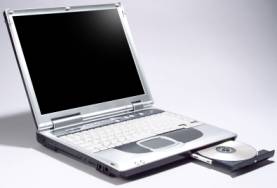
Entry-level (about $600) DeskNote i-Buddie A907 will replace A900 (on 733MHz VIA C3) and A901 (Intel Celeron), and will become the first DeskNote models on integrated Transmeta Crusoe TM5600 with 512Kb L2 cache, intergrated memory controller (PC133 SDRAM), with 400-500MHz Pentium III performance. The first A907 model will feature the 533MHz chip, the following — 600, 633, and 667MHz CPUs. A907 bottom price is promised to be about $560 and even lower (speaking of barebones without memory, HDD, etc.) The complete A907 specifications are here.
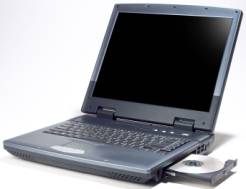
Unlike A907, lacking the CPU upgrade capability, the DeskNote i-Buddie A980 serie enables to install 2.26, 2.53, 2.8GHz Pentium 4 with 533MHz FSB, and the A929 serie (i-Buddie XP; specifications here) — Athlon XP. The A980 serie will feature the SiS651 chipset with SiS315-based graphics (16-64Mb of system memory) and also the models on NVIDIA GeForce4Go 420 with "own" 32Mb DDR. In addition DeskNote models utilize usual memory modules instead of SO-DIMM, but, unlike the A907 serie supporting the 168-pin PC133 SDRAM, the high-end A980 supports 2.5V 184-pin DDR33 SDRAM. A928 and A929 series (i-Buddie4 on Pentium 4 with 400MHz FSB; specifications here) also support the 184-pin DDR SDRAMm however only with PC2100.
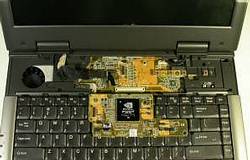
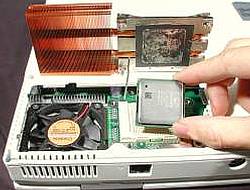
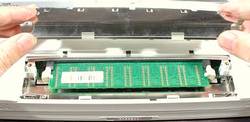
Another interesting feature of the A980 serie is the opportunity of purchasing a model with brighter 15" TTL LCD, previously mainly used in LCD monitors. Naturally, this will affect the weight and depth and will reduce the operation time. Though the A980 serie will feature models with 15" LVDS panels as well. In general, Elitegroup plans to expand the list of larger-display models in 2003.
The new DeskNote products still feature the 2.5" hard drives, however, they can be replaced by unscrewing two screws and mounting the drive into the special bay. Other standard features include the V.90 56Kbps modem, 10/100Mbps LAN and USB ports. Floppy drives and PCMCIA slots are becoming the past, the high-end A928, A929, A980 feature USB 2.0 and IEEE1394.
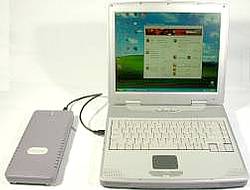
As the desktop CPUs are still the main DeskNote feature, the company positions battery only as an option.
|
ECS DeskNote (i-Buddie) series, 2003
|
| |
i-Buddie A907 |
i-Buddie4 A928 |
i-Buddie XP A929 |
i-Buddie4 A980 |
| CPU |
Transmeta Crusoe TM5600 500-667MHz | Pentium4 1.6-2.4GHz |
Athlon XP 1500+ — 2600+ |
Pentium4 2.26-2.8GHz |
| Display, inches |
13.3 / 14.1, LCD |
14.1 / 15, LCD |
14.1 / 15, LCD |
15, TTL / LVDS, LCD |
| Resolution |
1024 x 768 (XGA) |
1024 x 768 (XGA) |
1024 x 768 (XGA) |
1024 x 768 (XGA) |
| Chipset |
ALi M1535 |
SiS650 + SiS961 |
SiS740 + SiS961 |
SiS651 + SiS962 |
| Graphics |
SiS305 |
SiS315 |
SiS315E |
SiS315 (GeForce4 Go420) |
| Peripherals |
COM, VGA, RJ-11, RJ-45 LAN, 4 õ
USB 1.1 | S-video (TV), VGA, RJ-11, RJ-45
LAN, 4 õ USB 2.0, IEEE1394 | S-video (TV), VGA, RJ-11, RJ-45
LAN, 4 õ USB 2.0, 2 õ IEEE 1394, graphics card slot |
| Memory |
128/256Mb SDRAM |
256Mb DDR SDRAM |
256Mb DDR SDRAM |
| Weight |
2.2 kg |
3.18 kg |
3.25 (LVDS), 4.2 kg (TFT) |
Source: The DigiTimes
Write a comment below. No registration needed!
|
|






